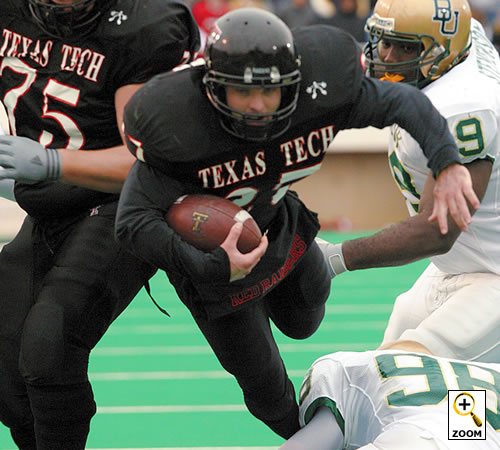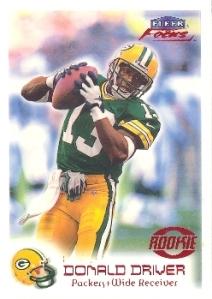While General Managers, Coaches, and Scouts will be the first to tell you that the videotape is the undisputed king as far as talent evaluation goes, many will admit to still being enthralled by the general athleticism and heft of the numbers put up by potential football prospects in a shirt and shorts.
Many have cited how the 40 yard dash means little and for the most part it does not mean a whole lot on its own but as the NFL pundits like to say, it’s all about the overall package and the numbers are yet another piece of the prospect puzzle.

Credit to maxpreps.com
NFL fans love to point out to wide receiver Aquan Boldin and his abysmal 4.72 40 yard dash at the 2003 NFL Combine, ignoring his solid enough numbers elsewhere including a 33.5″ vertical jump and 4.33 in the 20 yard short shuttle. To little surprise, he improved with a 4.59 dash at his Pro Day workout, more in-line with his field speed.
A similar player case for the 2014 NFL Draft comes in the form of outside linebacker Tyler Starr out of FCS South Dakota. He’s been moving steadily up draft boards to a potential 5th-7th round selection after putting up an explosive 4.15 20 yard shuttle and insane 6.64 3 cone drill number. Yet, he ran a sloth like 4.95 40 while weighing just 250 pounds. The difference? He admitted to struggling at the NFL Combine on that run and noticeably improved to 4.58 dash at his Pro Day workout, much more in-line with the other numbers he had put up.
Diminutive but electrifying running back Darren Sproles came out of Kansas State in the 2005 NFL Draft and was just a 4th round draft choice of the San Diego Chargers, mostly dropping due to his height of 5’6″ but he showcased his ability with 23 reps on the bench and a mind boggling 3.96 time in the 20 yard short shuttle.

Credit to kckpreps.com
Tony Villiotti of draftmetrics.com did a stunning job amassing NFL Combine data from 1999-2012 and pointing out correlations to positions on the football field. My favorite drills to focus on tend to be the following: bench press (except for WRs/DBs), vertical jump, and the 20 yard short shuttle.
The bench press, especially for TE, OL, DL, and LB are a good indicator of physical strength as they are required to often take on players who weigh anywhere from 230-300 pounds on a given play. While the bench press is more of an endurance feat, it also gives a small insight to whether the player has utilized the weight room well during their collegiate career. I mainly look for a minimum of 20 reps here although my benchmark is 18 for small school players whom may not have similar facilities on their campuses.

Credit to footballeducator.com
The vertical jump measures explosiveness generated by the legs from a stand still and also measures a degree of athletic ability. The two positions that often require physically leaping in the air, wide receivers and defensive backs, also tend to generate the most players with say 38″ or 39″ vertical jumps. At his Pro Day, Calvin Johnson leaped 42.5″ and earned his nickname of Megatron almost immediately. On the other side of the football field, CB Darrelle Revis jumped 38″ at his Pro Day and Richard Sherman, despite pedestrian 4.53 and 4.54 40s put up two jumps of 37″ and 38″ in the vertical. For TEs and LBs I am mainly looking for 30″ while OL/DL can be 28″ or higher preferably. WRs and DBs generally need to be around 34″ minimum.
Now we come to my favorite drill, the 20 yard short shuttle as it arguably encapsulates absolutely everything needed on a football field. You start upfield for 5 yards from a dead stop, flip your hips around a cone, stop/swivel your hips in a loop around the far cone, straight line sprint for 5 yards back to the first cone, then flip your hips again back to the finish line. It’s not uncommon to read that many scouts and coaches place emphasis, if not heavier emphasis, on this drill the most as it can correlate to every position on the football field and basically does the following drills: 40 yard dash (5 yard split arguably), 3 cone drill in terms of hip flexibility, and vertical jump in terms of immediate explosion in those initial 5 yards.

Credit to nationalchamps.net
Wes Welker was notably undrafted in the 2004 NFL Draft and was rather unimpressive athletically; he ran a 4.65 40 and only had a 30″ vertical jump. Where he blew it away was his 4.01 time in the short shuttle, a number he has deftly displayed in his maneuvers on the field sprinting 5-10 yards and leaving linebackers or even safeties in the dust. For comparison, speedy wide receiver Lee Evans (taken 13th overall in 2004) had a 4.02 short shuttle time despite running a 4.39 40 yard dash and out jumping Welker by 4.5″ on the vertical.
This drill has also lent itself to talented sack artists on the defensive side of the ball as well, showcasing their ability to explode off the snap then bend immediately in 5 yards: Terrell Suggs ran a 4.44, Mario Williams had 4.37 at 295 pounds, Justin Tuck had a 4.29, Ndamukong Suh had a 4.44 at 307 pounds, and J.J. Watt had a 4.21.
For RBs and WRs I look for a 4.25 or lower. For TEs/LBs I look for a 4.40 or lower. For OL/DL I look for a 4.60 or lower (weight depending as a 320 pound player running a 4.70 is pretty impressive). For DBs I look for a 4.20 or lower.

Credit to sportscardforum.com
While the workout numbers don’t mean everything, they also have a heavy impact on smaller FBS and FCS school players, especially at their Pro Day workouts. A good workout or great number in a few categories can vault a player from undrafted to potentially a priority undrafted (the guys signed immediately after the draft) or even 7th round selections by teams afraid of losing them to competition. Examples include WR Donald Driver whom was a 7th round selection by Green Bay coming out of Alcorn State, the school that also produced QB Steve McNair.
So with all that said, here are some players who you should be keeping an eye on (or ear out for) during the NFL Draft when it airs starting May 8th and ending May 10th.
**RB David Fluellen [Toledo]: Ran a pedestrian 4.66 40 but flashed a 38″ vertical and 4.21 shuttle. Ran for 1,498 and 1,121 yards the past 2 seasons. Could work himself into a late round pick.
**RB Tre Mason [Auburn]: Ran a 4.50 40 but flashed a 38.5″ vertical and 4.15 shuttle. In a battle with Lache Seastrunk (Baylor) and Bishop Sankey (Washington) as the 1st RB to be selected in the draft.
**WR Jared Abbrederis [Wisconsin]: Much like Welker, an average athlete with a 4.50 40 and 30.5″ vertical but exploded with a 4.08 shuttle. Had 3 straight seasons over 835 yards receiving. Likely to go in the middle rounds of the draft.
**WR Brandin Cooks [Oregon State]: Put up a 36″ vertical and crazy 3.81 shuttle time. Potential to sneak into the late 1st round.
**TE C.J. Fiedorowicz [Iowa]: 31.5″ vert but more impressive 4.26 shuttle. Known more for his blocking, could be a 2nd to 3rd round pick.
**OL Jake Matthews [Texas A&M] and Greg Robinson [Auburn]: Battling each other for 1st OT off the board. Matthews = 24 bench, 30.5″ vertical, and 4.47 shuttle vs. Robinson = 32 bench, 28.5″ vertical, and 4.86 shuttle.
**DL Scott Crichton [Oregon State]: 24 bench, 31.5″ vertical, and 4.29 shuttle. Has been steadily rising and could be a 2nd-3rd round selection.
**LB Max Bullough [Michigan State]: Flying under the radar a bit despite a 30 bench, 31″ vertical, and 4.29 shuttle performance. Talented player in college and is expected to go anywhere from 2nd to 4th round.
**DB Ricardo Allen [Purdue]: Explosive athlete with 37″ vertical and 4.10 shuttle despite only being 5’9. Should be a late round selection.
**DB Hasean Clinton-Dix [Alabama]: 33″ vertical but impressive 4.16 shuttle has him moving into a probable 1st round selection, battling Calvin Pryor (34.5″ vertical and 4.31 shuttle) for first FS to be selected in the draft.
Two noteworthy sites to get your Pro Day fixes are Gil Brandt at NFL.com and Tony Pauline at walterfootball.com.
Hope you enjoyed the read and are suitably hyped for the NFL Draft just a little over a month away!

